MARIANI’S
Virtual Gourmet
October 4,
2015
NEWSLETTER
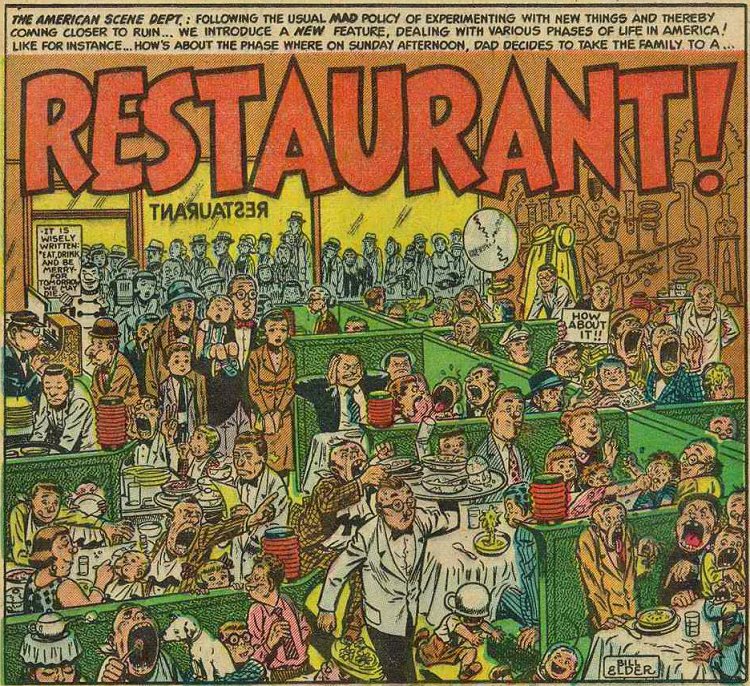
"Restaurant!"
Mad Comics
(October, 1954)
IN THIS ISSUE
DINING OUT ON NEVIS
By John Mariani
NEW YORK CORNER
FLEMING'S STEAKHOUSE
By John Mariani
NOTES FROM THE WINE CELLAR
HOW TO MANAGE 66 CELLARS
By John Mariani
❖❖❖
IMPORTANT
ANNOUNCEMENT
From John Mariani
Owing to the
inscrutability of my website server, more than
8,500 subscribers were "accidentally" blocked from
receiving the Virtual
Gourmet, without my knowledge, which
explains why some of you have asked me why you
have not been receiving the last few issues. I
have--painstakingly--restored those subscribers
and I welcome you back wholeheartedly and
apologize for the lapse. And remember, any
time you want to read the current issue or go to
the archive just go to: johnmariani.com.
❖❖❖
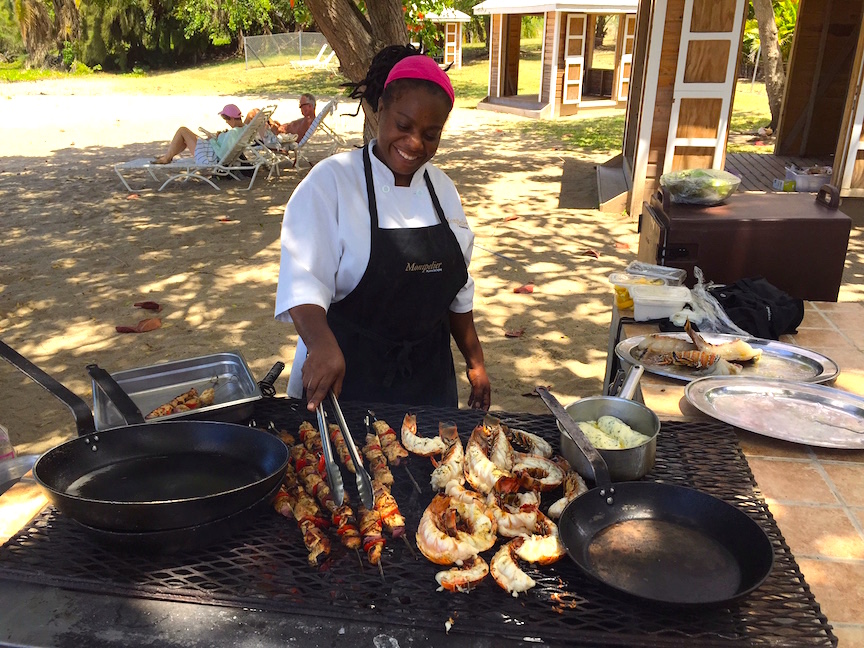
Beach Barbecue by Montpelier Plantation
Last week in this newsletter I
wrote about Nevis as an island that has maintained
its unique Caribbean character, history and
culture, with only one large resort, The Four
Seasons. So,
too, in addition to many restaurants offering a
diversity of European or American cuisines, most
of the villas and guesthouses strive to serve food
of the islands--as often as possible on a
sun-bleached beach.
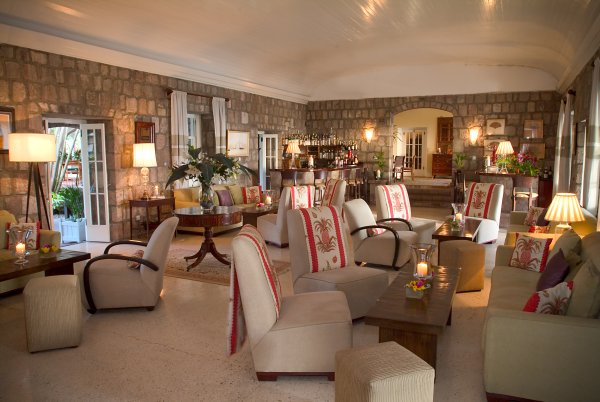 On my recent stay at Montpelier
Plantation, sequestered amidst tropical
greenery and built into the island’s rocks of the
foothills, I found that as much as possible
everything is made on the premises, including
excellent breads in the morning, along with pastries
and fresh fruits.
On my recent stay at Montpelier
Plantation, sequestered amidst tropical
greenery and built into the island’s rocks of the
foothills, I found that as much as possible
everything is made on the premises, including
excellent breads in the morning, along with pastries
and fresh fruits.
At night, after rum cocktails in
the villa’s Great Room (left), dinner is served at
Restaurant 750 on the candle-lighted verandah, where
Chef Stéphane Caumont shows off his French technique
in adapting dishes to global and Caribbean flavors,
like his superb yellowfin tartare with wakame
seaweed, avocado, and spicy wasabi mayonnaise. He
marinates Bell peppers in a salad with goat’s
cheese, spinach and serves it with housemade
breadsticks.
Red snapper is ubiquitous on
menus down there and Caumont does a splendid
rendition, carefully pan-seared and sided with
assorted vegetables, an herbed couscous and a
deliciously tart lemon beurre blanc. French
chefs often overdo pastas and Caumont’s
spinach-ricotta ravioli came lavished with pecorino
cream, raisins, pine nuts, and a sun-dried tomato
pesto, with confused results. Also, serving only six
ravioli as a main course seemed a little ungenerous.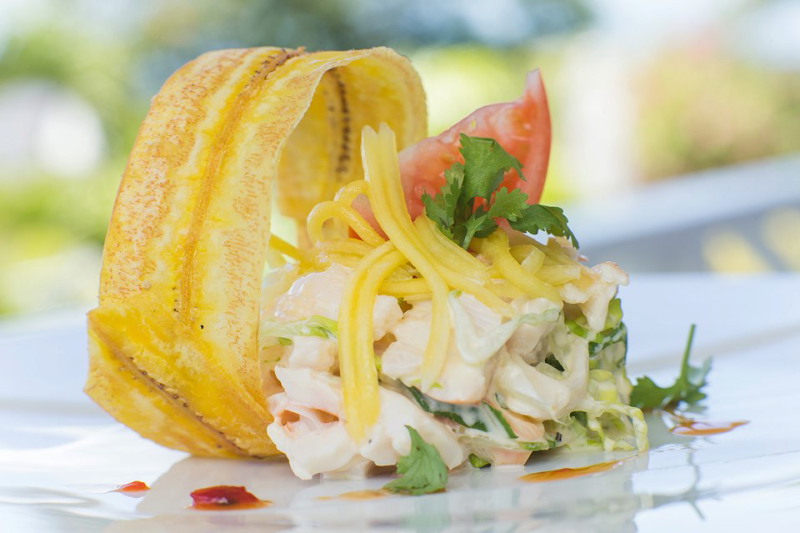
Desserts proved to be as good as all breads
and pastries at Montpelier. White chocolate mousse
with passion jelly, coconut foam, crumble, and cocoa
was delightful that evening, but I also sampled the
cheeses--unexpected in the Caribbean--and found them
first-rate.
All of this is accompanied by a reasonably
priced wine list that covers all bases for this kind
of cuisine. The
fixed price menu is $78, plus 24% tax and service
charge, so you need not tip further.
In keeping with the hospitality here, the
villa is happy to pack a picnic lunch for
beachgoers, and upon leaving, we were given the same
for our ride back to the airport. This is a
very civilized place where the staff bends over
backwards to please you from joyous arrival to one’s
sad leaving.
I noted The Four
Seasons (below), which sprawls over the
landscape at Pinney's Beach with its own golf
course, tennis courts, state-of-the-art spa, many
family activities, luxury beach houses, and several
options for dining. Despite its size (and a
hurricane put it out of business for two years), the
resort intrudes very amiably into the landscape, and
the architecture fits the island impeccably, with a
profusion of as much greenery as possible.
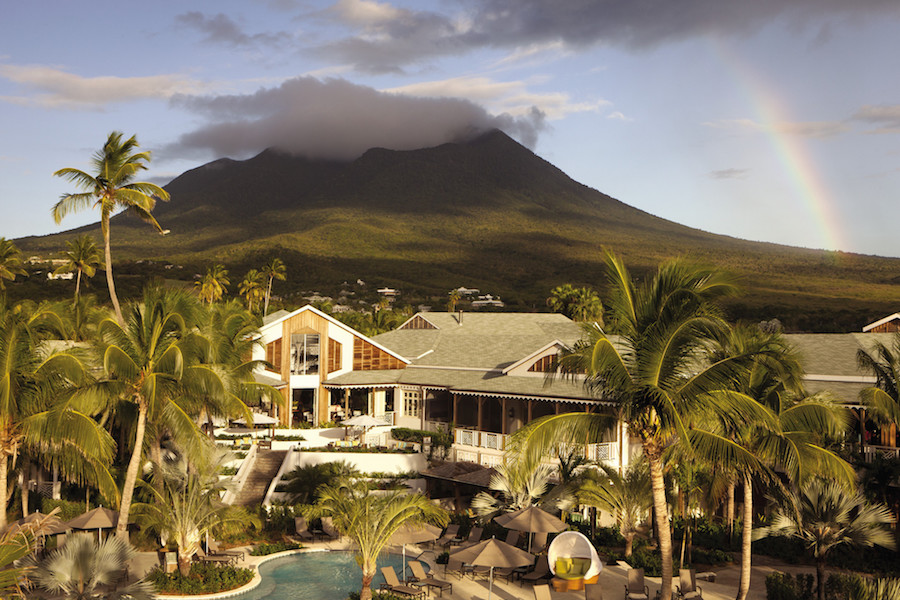 We
opted to dine at the resort's Mango restaurant,
whose
101 Bar takes its name from the same number of rums
it stocks, arrayed and lighted against the wall like
bottles of amber.
Here they happily do flights of three rums
for you to taste; we tried a Ron Zacapa XO, an El
Dorado 21 Year Old, and a Clément 10 Year Old. Many of
the rums here don’t reach the U.S., so you can get a
quick education on what you’ve been missing.
We
opted to dine at the resort's Mango restaurant,
whose
101 Bar takes its name from the same number of rums
it stocks, arrayed and lighted against the wall like
bottles of amber.
Here they happily do flights of three rums
for you to taste; we tried a Ron Zacapa XO, an El
Dorado 21 Year Old, and a Clément 10 Year Old. Many of
the rums here don’t reach the U.S., so you can get a
quick education on what you’ve been missing.
Mango (which will be closed for two weeks at
the end of October) is a casual spot best
appreciated at twilight, when the sun is going down
in its fiery dramatic fashion, sometimes with a
green flash on the horizon, famous in the Caribbean.
The menu is Caribbean, and we enjoyed dishes like
crisp, hot barbecued empanadas
stuffed with juicy pulled pork and plantains with a
terrific avocado-garlic aïoli; Caribbean snapper,
served whole, is dusted with Cajun seasoning,
dredged in flour and fried, with cassava fries on
the side and mango-tomato salsa; divers’ scallops
are quickly seared with Cajun spices and served with
lush and creamy guacamole and wonderfully tangy
pickled mango. There’s even wagyu-style
beef fajitas,
and for dessert rice pudding, rum cake, and
chocolate mousse, all of which are well complemented
by an after-dinner tot of rum. Maybe even a flight.
On another evening we joined a jolly bar
crowd at Hermitage
in Figtree Parish, whose wooden house is said to be
the oldest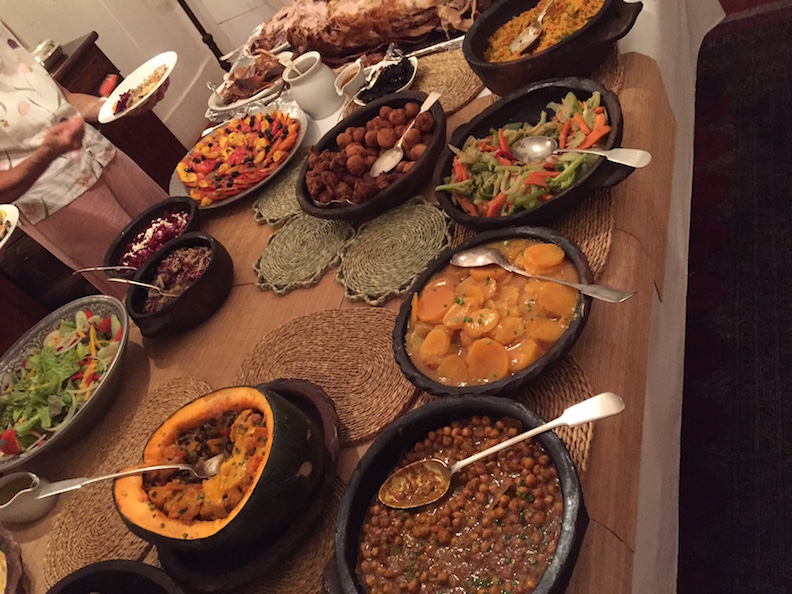 on the island,
carefully restored and maintained by the Lupinacci
family of Philadelphia, who have owned it since
1971. A
Caribbean “Pig Night” buffet and pig roast was in
full swing, prepared by local Nevisian cooks Lenny
Liburd and his assistant Super Cat cook, who smoke
and carve the pig and surround it with many ceramic
pots of sweet potatoes, red beans, johnnycake, rice
and salads galore. Everyone helps himself, everyone
laughs, everyone goes back for seconds and thirds.
on the island,
carefully restored and maintained by the Lupinacci
family of Philadelphia, who have owned it since
1971. A
Caribbean “Pig Night” buffet and pig roast was in
full swing, prepared by local Nevisian cooks Lenny
Liburd and his assistant Super Cat cook, who smoke
and carve the pig and surround it with many ceramic
pots of sweet potatoes, red beans, johnnycake, rice
and salads galore. Everyone helps himself, everyone
laughs, everyone goes back for seconds and thirds.
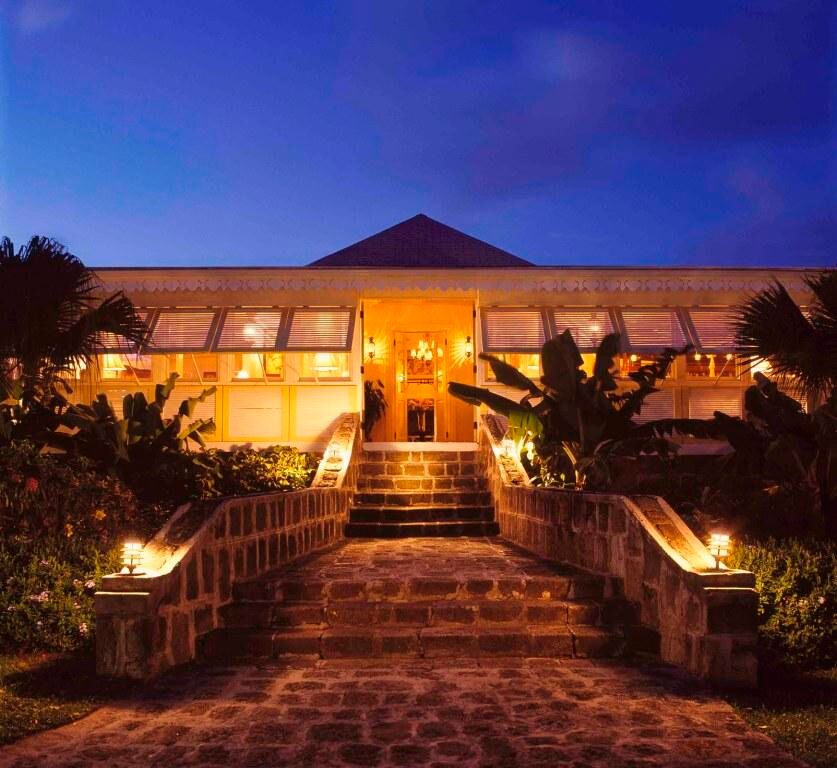 Owner David
Dodwell’s Nisbet
Plantation in Newcastle on the beach has
long been considered one of Nevis’s finest
restaurants and villas, and our experience did
nothing to disprove the claim. It is
such a pretty dining room (left), full of fine antiques and
historic artwork, as is the windswept verandah
within view of a vast lawn leading down to the sea. Our
dinner, by Filipino-born Chef Tony Piani, included
tender roasted pumpkin and creamy green pea risotto
and prosciutto crisps; expertly fried tempura of
sweetbreads and cauliflower with a lemon caper
drizzle; and a superb Korean-style beef tenderloin
with an egg noodle stir-fry and Asian vegetables. These
were all so good and out of the ordinary for a
Caribbean restaurant that the sautéed chicken breast
with wild rice pilaf and Marsala mushroom sauce
seemed a tame throwback dish. For dessert the
chocolate opéra
gâteau was an impressive, decadent rendering.
Owner David
Dodwell’s Nisbet
Plantation in Newcastle on the beach has
long been considered one of Nevis’s finest
restaurants and villas, and our experience did
nothing to disprove the claim. It is
such a pretty dining room (left), full of fine antiques and
historic artwork, as is the windswept verandah
within view of a vast lawn leading down to the sea. Our
dinner, by Filipino-born Chef Tony Piani, included
tender roasted pumpkin and creamy green pea risotto
and prosciutto crisps; expertly fried tempura of
sweetbreads and cauliflower with a lemon caper
drizzle; and a superb Korean-style beef tenderloin
with an egg noodle stir-fry and Asian vegetables. These
were all so good and out of the ordinary for a
Caribbean restaurant that the sautéed chicken breast
with wild rice pilaf and Marsala mushroom sauce
seemed a tame throwback dish. For dessert the
chocolate opéra
gâteau was an impressive, decadent rendering.
Next day we were at the
Chrishi
Beach Club (below) on Cade Bay, where Hedda 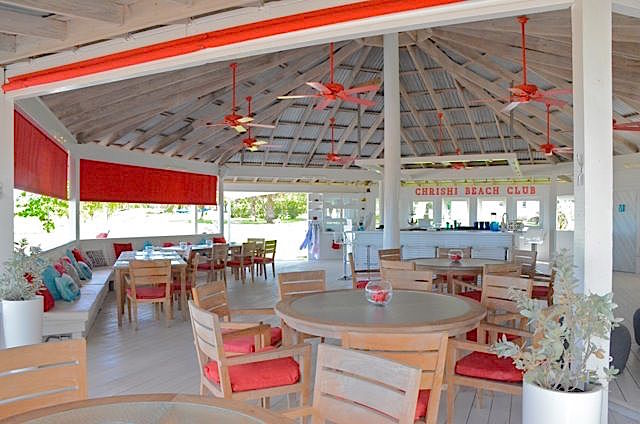 and Christian Wienpahl
have fashioned the ideal spot to have good, casual
food and drinks on a snowy white beach, with a good
kitchen that turns out the island’s best
burgers--seven different kinds--a creamy roasted
tomato and red pepper soup full of fresh shrimp, and
five-spice slow-roasted duck noodle stir fry. You
come to the beach in your bathing suit, you have
some lunch, you stay a little longer at the beach,
have a cold beer, lean against the pillows, and soon
the afternoon has been successfully shot.
and Christian Wienpahl
have fashioned the ideal spot to have good, casual
food and drinks on a snowy white beach, with a good
kitchen that turns out the island’s best
burgers--seven different kinds--a creamy roasted
tomato and red pepper soup full of fresh shrimp, and
five-spice slow-roasted duck noodle stir fry. You
come to the beach in your bathing suit, you have
some lunch, you stay a little longer at the beach,
have a cold beer, lean against the pillows, and soon
the afternoon has been successfully shot.
At Sunshines Bar &
Grill, on Pinney Beach, a kind
of overstuffed shack of memorabilia and flags left
by celebrity guests, the best items are the BBQ
chicken ingsand lobster sandwich, and the signature
drink to have is the powerfully rum-based "Killer
Bee" rum punch, which goes down way too easily.
Another very casual option is Bananas Bistro
on the
Hamilton Estate, founded by Jillian Smith, a
former can can dancer turned hotelier. Opened
on a shoestring and named more for her state of
mind than for its trees, Bananas Bistro has a
rustic, funky charm best appreciated on the verandah,
where we enjoyed a chunky lobster salad sandwich,
snapper with lemon butter sauce and fragrant basmati
rice; and a spicy Thai red curry; and a delicious
platter of sticky guava barbecued ribs with
Caribbean cole slaw.
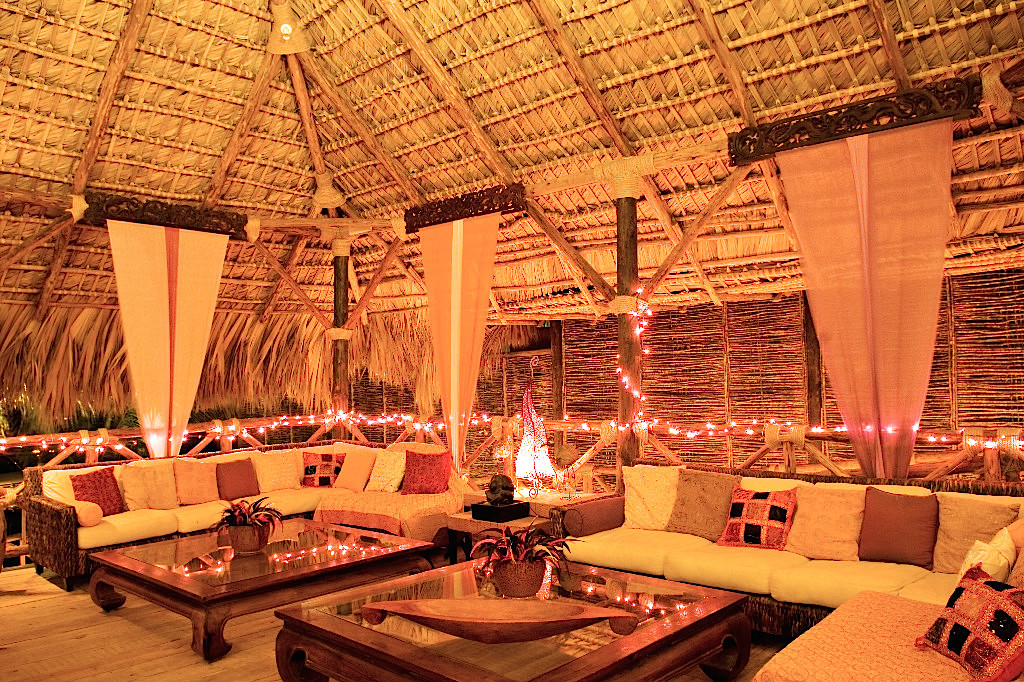 Our
last
meal on island was in a remarkable spot, Coconut
Grove Restaurant at Nelson's Springs,
which appends “Wine Lounge” to its name for good
reason. Owners Karin and Gary Colt maintain an
amazing temperature-controlled cellar of fine wines
you’d be hard put to find anywhere in the Caribbean. The
buildings here are all thatched, so you dine under a
tall canopy, looking out to the sea and up to the
stars. Chef
Stephen Smith makes his own pastas as well as a
cream foie gras torchon laced with rum, a baked
Camembert round touched with Calvados, and an
abundant Creole-style seafood stew; there’s even a
mole poblano on the menu, served over rice with nuts
and coconut shavings.
Our
last
meal on island was in a remarkable spot, Coconut
Grove Restaurant at Nelson's Springs,
which appends “Wine Lounge” to its name for good
reason. Owners Karin and Gary Colt maintain an
amazing temperature-controlled cellar of fine wines
you’d be hard put to find anywhere in the Caribbean. The
buildings here are all thatched, so you dine under a
tall canopy, looking out to the sea and up to the
stars. Chef
Stephen Smith makes his own pastas as well as a
cream foie gras torchon laced with rum, a baked
Camembert round touched with Calvados, and an
abundant Creole-style seafood stew; there’s even a
mole poblano on the menu, served over rice with nuts
and coconut shavings.
Too often in the Caribbean,
restaurants try to please tourists' taste with the
same common denominator in the assumption
that was it local is of little interest. On
Nevis, restaurants at the top of the hill and down
on the beach are more representative of a cuisine
that came on the tradewinds, made by people who
are proud of that long, well-seasoned heritage of
local and foreign flavors.
MICHELIN
NEW YORK GUIDE 2016:
PLUS ÇA
CHANGE PLUS C’EST LA MÊME CHOSE
By
John Mariani
Whatever the relevance of the
Michelin Guides
to U.S. Cities (NYC, San Francisco, Chicago) still
have is shown in the brand new 2016 (11th)
edition for New York, whose one-, two-, and
three-star ratings manifest the same idolization of
the most expensive dining experiences in the city,
together with a fondness for those chefs who only
serve multi-course meals of 20 courses and more. 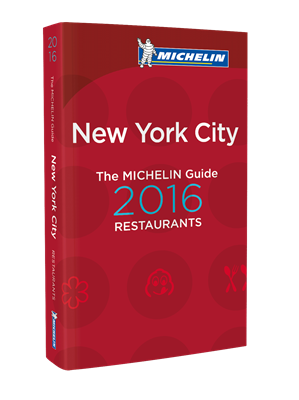
The six in the three-star
category have not changed in years, nor have the
silly explanations of what the stars mean: three
stars “Exceptional cuisine, worth a journey”;
"Excellent cuisine, worth a detour"; “A very good
restaurant in its category.” When Michelin (owned
by the tire company) began as a guide strictly for
chauffeurs in France back in the 1920s, the idea of
“worth a special journey” or “worth a detour” made a
certain sense while driving wealthy employers around
the country. But
they are meaningless today.
Also, the Guides’
expressed criteria are highly questionable, given
the restaurants that get three stars: “Only the
quality of the cuisine is evaluated. To fully assess
the quality of a restaurant, the inspectors apply
five criteria defined by Michelin: "product quality,
preparation and flavors, the chef's personality as
revealed through his or her cuisine, value for
money, and consistency over time and across the
entire menu.”
These criteria—which are supposed to
apply to all restaurants
on their list--contend that décor, service, wine
list, and other factors have nothing whatever to do
with their ratings. Nevertheless, only very
expensive, deluxe dining rooms make their top tier,
except for the Japanese sushi restaurant Masa, which
is fairly spare.
Yet the Guide
gives a star to only two NYC steakhouses, Peter
Luger’s in Brooklyn, where, despite the indisputable
quality of their porterhouse, there is a lot on the
menu few gourmands would rank as out-of-the-ordinary
or even very good.
Did the Michelin
inspector really taste Luger’s desserts? Like most
other steakhouses in NYC, Luger does not make its
all its own, buying its cheesecake from S&S, so
I'm not sure where the chef's personality lies in
that. The other one-star steakhouse is M. Wells in
Queens, which is located in a garage. So, are
they suggesting not a single other NYC steakhouse
can be ranked as “very good within its category?” Porter House?
Smith & Wollensky? Spark's? Strip
House? It’s preposterous.
Then there’s that line about how
“the chef's personality [is] revealed through his or
her cuisine.”
Again, does Luger even have a head
chef with a personality? And does Bibendum (below) ever
care if the chef ever really cooks in his
restaurant, as is the case with so many of its
three- and two-star restaurants? When was the last
time the expansionist chef-owners of Carbone went
into the kitchen?
How much time does Mario Batali spend at Casa
Mono or Del Posto?
 As for Michelin’s
inspectors, they do (“famously”) go anonymously and
they do pay for their meals. But the
last time I asked the director of the Guides how
many inspectors there were for NYC, I was told
five--just five--and only one of them was full-time
in Manhattan.
The 2016 Guide
lists 900 restaurants (of about 16,000 in NYC),
which works out to 180 restaurants per year per
inspector. I do not envy them. And they
supposedly pay multiple visits if a
restaurant is up for a star. And they
normally dine alone, not with a table of four. And
in NYC, lunch menus often bear little resemblance to
dinner menus, so do they judge a restaurant on soup,
salad, burger, and sandwich at lunch?
As for Michelin’s
inspectors, they do (“famously”) go anonymously and
they do pay for their meals. But the
last time I asked the director of the Guides how
many inspectors there were for NYC, I was told
five--just five--and only one of them was full-time
in Manhattan.
The 2016 Guide
lists 900 restaurants (of about 16,000 in NYC),
which works out to 180 restaurants per year per
inspector. I do not envy them. And they
supposedly pay multiple visits if a
restaurant is up for a star. And they
normally dine alone, not with a table of four. And
in NYC, lunch menus often bear little resemblance to
dinner menus, so do they judge a restaurant on soup,
salad, burger, and sandwich at lunch?
So, looking down the list beyond
three stars (Chef's
Table at Brooklyn Fare, Eleven
Madison
Park, Jean-Georges,
Le
Bernardin, Masa,
Per Se--all of
them deserving), one has to wonder why
restaurants few people have ever heard of (Ichimura,
Soto, Jungsik) would be “worth a detour,” but that
restaurants widely recognized both by New York and
national media fall into the merely “very good”
category, like Ai Fiori, Aureole, Bâtard,
Betony,
Blue
Hill, and Bouley—I’m
only up to the “B”s here. How can a gastropub like The
Breslin rank alongside Gramercy Tavern or Telepan? How can
restaurants like La Grénouille, Le Cirque, Benôit,
Four Seasons, and Nobu not make the cut at
all? Of course, the trouble is, most people
just look at the stars rather than read the text,
which even for un-starred restaurants is, overall,
very positive. The Bib Gourmand entries of
restaurants where you can dine well for under $35 is
invaluable.
And don’t get me started on
Michelin’s continuing dismissal of Italian
restaurants as beneath star consideration. Aside
from Marea (two stars), only four Italian
restaurants receive even one star—this in a city
that unquestionably has some of the finest Italian
restaurants in the world, including Italy.
Oddly enough, the number of starred Japanese
sushi bars in the Guide now numbers a hefty
thirteen; by the same token, though the NY Times awarded
Sushi Nakazawa four stars, Michelin gives it
zero. (Then again, the stars from the Times have
become as meaningless as inflated grades at Ivy
League schools.)
Congrats to all the winners this
year, but it’s hard to take Michelin seriously
outside of France, where long familiarity with a
specific kind and style of cuisine makes it worth
one’s while to follow. But outside of France, the Guide now
elicits a well-deserved shrug, except among those
who love to gossip about who made the list and who
didn’t. And
those people are unlikely ever to make a “special
journey” or “detour” to Michelin’s favorites.
❖❖❖
NEW YORK CORNER
By John Mariani
FLEMING'S PRIME STEAKHOUSE & WINE
BAR
90 The Promenade, Edgewater, NJ
201-313-9463
flemingssteakhouse.com
The most romantic view
of NYC in
NYC is from the Rainbow Room atop Rockefeller
Center. But
the ones that movie makers--not least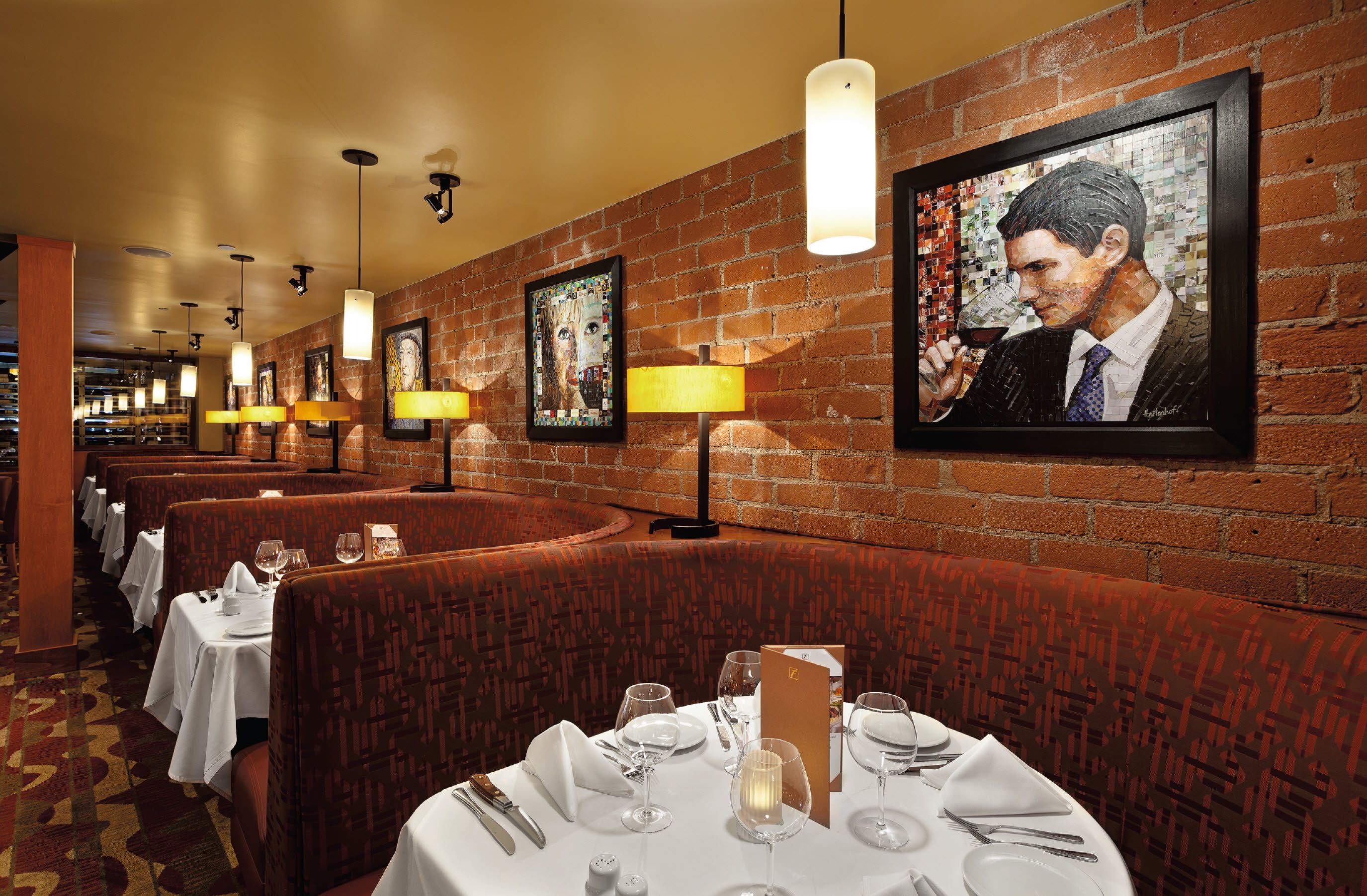 Woody
Allen--use is from either the Brooklyn or New
Jersey sides, which show off both
the horizontal and vertical majesty of the city
at night.
Woody
Allen--use is from either the Brooklyn or New
Jersey sides, which show off both
the horizontal and vertical majesty of the city
at night.
An easy
trip over the George Washington Bridge, through
the Lincoln Tunnel or on the Port Imperial Ferry
brings you to a location from which the city’s
sparkling glamour may be viewed, all while you sip
good wine and consume Prime steaks.
Fleming’s Prime Steakhouse & Wine Bar in
Edgewater, in the City Place shopping mall,
provides just such a panorama, although I can’t
imagine why the architect cut off the sightlines
at a certain height so that you need to rise from
your table to take it all in.
For a steakhouse, this--one of
66 locations of a chain founded in 1998 and based
in California--has its own romantic cast of low
lighting (but not too low), warm brick and
huge window walls, big roomy booths, patterned
carpeting, wine-related artwork, and well-set
tables with white cloths and napkins; the soft
surfaces admirably soak up noise.
I don’t as a rule review chain
restaurants, at least not ones like Outback
Steakhouse and Carrabba’s Italian Grill, which are
also part of the Bloomin’ Brands that owns
Fleming’s, but the claims for the quality of the
meat and the exceptional chosen wine list (see my
interview with Fleming’s wine director, Maeve
Pesquera, below) and the fact that it was in such
a delightful location just across the Hudson River
attracted me to see how well a steakhouse chain of
this size can pull it all off. Certainly
there are fans of other steakhouse chains like
Ruth’s Chris, Smith & Wollensky, and Palm,
which I’ve written about.
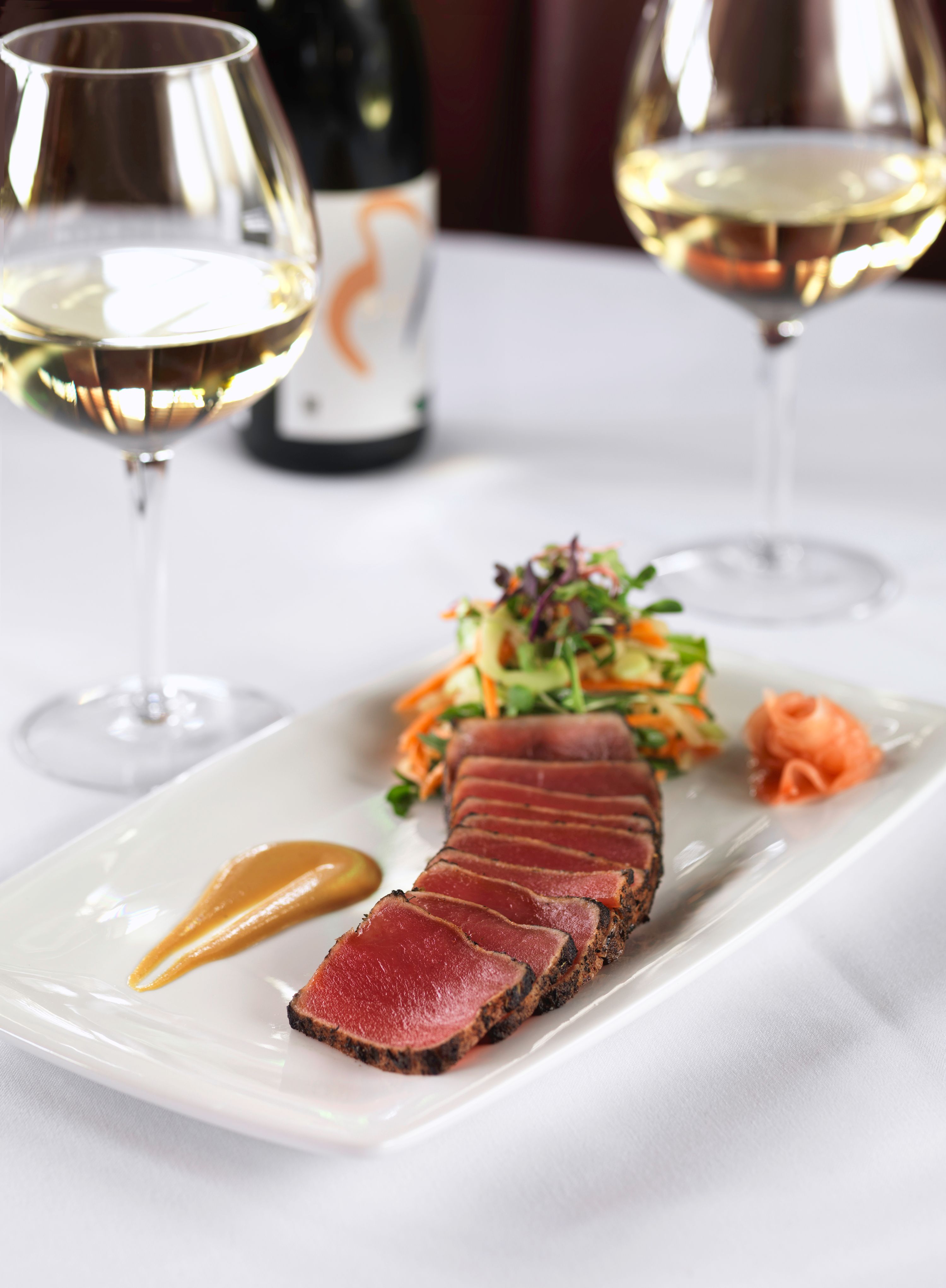 Our
party was warmly welcomed by Operating Partner Tom
McCarthy, and later by chef and partner David
Hawkins; our waiter, a fellow name Ricky, proved
himself as engagingly entertaining as he was
professional in describing the menu and answering
a slew of questions from our table. He even
laughed at our jokes.
Our
party was warmly welcomed by Operating Partner Tom
McCarthy, and later by chef and partner David
Hawkins; our waiter, a fellow name Ricky, proved
himself as engagingly entertaining as he was
professional in describing the menu and answering
a slew of questions from our table. He even
laughed at our jokes.
The wine list here, and at
every other Fleming’s, offers a collection of 100
wines by the glass--also available by the taste,
flight or bottle--all listed on the WiNEPAD™, a
proprietary web application that provides
label-specific tasting notes, the story behind the
wine, and innovative ways to learn about wine. You
might also inquire about Fleming’s Forty-Six Diamonds, a custom blend from
a boutique winery released in the fall at all
locations.
We began with a lavish seafood
tower of jumbo shrimp, lobster tails, and king
crab on ice (market price), all, as one might
expect, frozen product, though the shrimp suffered
from being ice cold and watery. French
onion soup ($11.95) was a very fine rendering of
this bistro classic, piping hot with
well-caramelized onions and a bubbly, browned
crust of both Gruyère and Parmesan cheeses.
The jumbo lump crabcakes ($19.50)
were delicious, very meaty as promised by their
size, served with a roasted red pepper and lime
butter sauce. Housemade burrata
($13.50) with charred grape tomatoes, arugula and
toasted garlic crostini (below) lacked
the flavor of rich cream I expected.
In addition to the appetizer selections and
salads, there is also a section of “small plates”
that might make for a lighter meal, though braised
shortribs with arugula and spinach ($19.95) would
be nicely filling.
There’s also lobster tempura with a soy
sauce and jicama salad ($26.95), and finely
textured ahi tuna, seared and served rare (above)
Of course, most people are
going to come here for steaks (oddly there are no
lamb chops on the menu) and wisely so. Fleming’s
uses USDA Prime, Certified Angus, and wagyu
grades, the last American Kobe-style beef
($57.95). They also have an interesting, signature 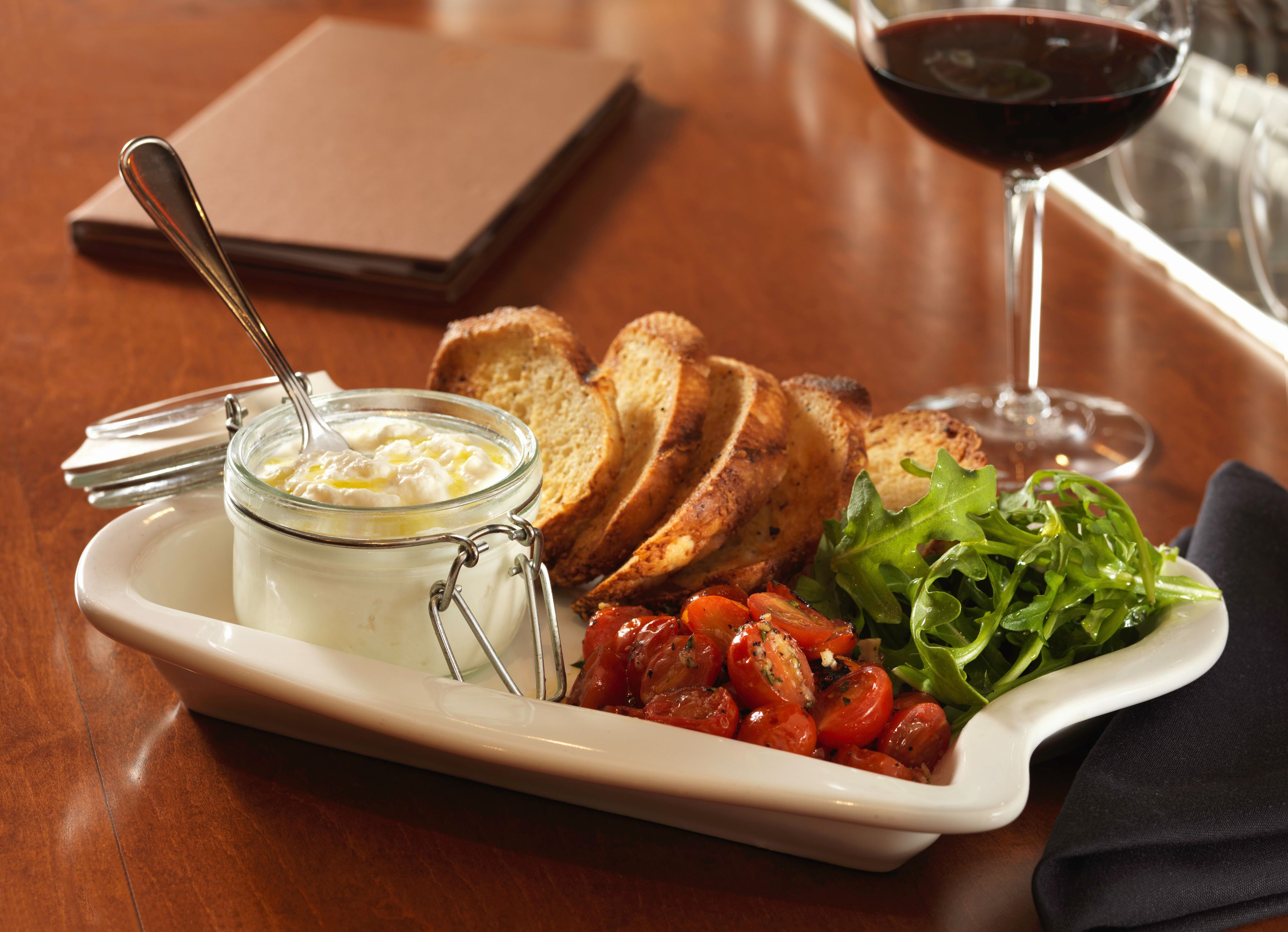 “Craftsman
ribeye” ($47.95) Certified Angus ribeye
hand-carved in a way that allows for a thicker cut
of 11 inches to be enjoyed by those who prefer
this juicier cut.
We tried all these, in addition to a very
good New York strip ($51.95)--my favorite of the
evening--and they made an argument that there is
good beef beyond the river banks of Manhattan.
They also made sure the steaks were cooked as
ordered: well crusted on the outside, medium-rare
within.
“Craftsman
ribeye” ($47.95) Certified Angus ribeye
hand-carved in a way that allows for a thicker cut
of 11 inches to be enjoyed by those who prefer
this juicier cut.
We tried all these, in addition to a very
good New York strip ($51.95)--my favorite of the
evening--and they made an argument that there is
good beef beyond the river banks of Manhattan.
They also made sure the steaks were cooked as
ordered: well crusted on the outside, medium-rare
within.
For
those who wish to stray from the recommended beef
route, there is barbecued Scottish salmon (farm
raised) that is slow roasted, with a mushroom
salad, and Chilean sea bass, which starts out wild
but is frozen at a fishery; it comes sautéed and
braised in a broth with wilted greens, potatoes
and chile-cilantro.
You would do well to order the
first-rate, very crisp stack of sweet onion rings
($10.95), but there is another signature item
here--Fleming’s Potatoes, heavily enriched with
cream, the bite of jalapeños, and plenty of
cheddar cheese ($11.95). Creamed spinach was
considerably lighter ($10.50).
I wrote a few weeks back about
the superb desserts at Costata steakhouse in
Greenwich Village, but Fleming’s is more in the
tradition of serving solid standards like
chocolate lava cake ($13.50), a fine crème brûlée
($10.95), and nicely moist carrot cake ($10.50)
that was not cloyingly sweet.
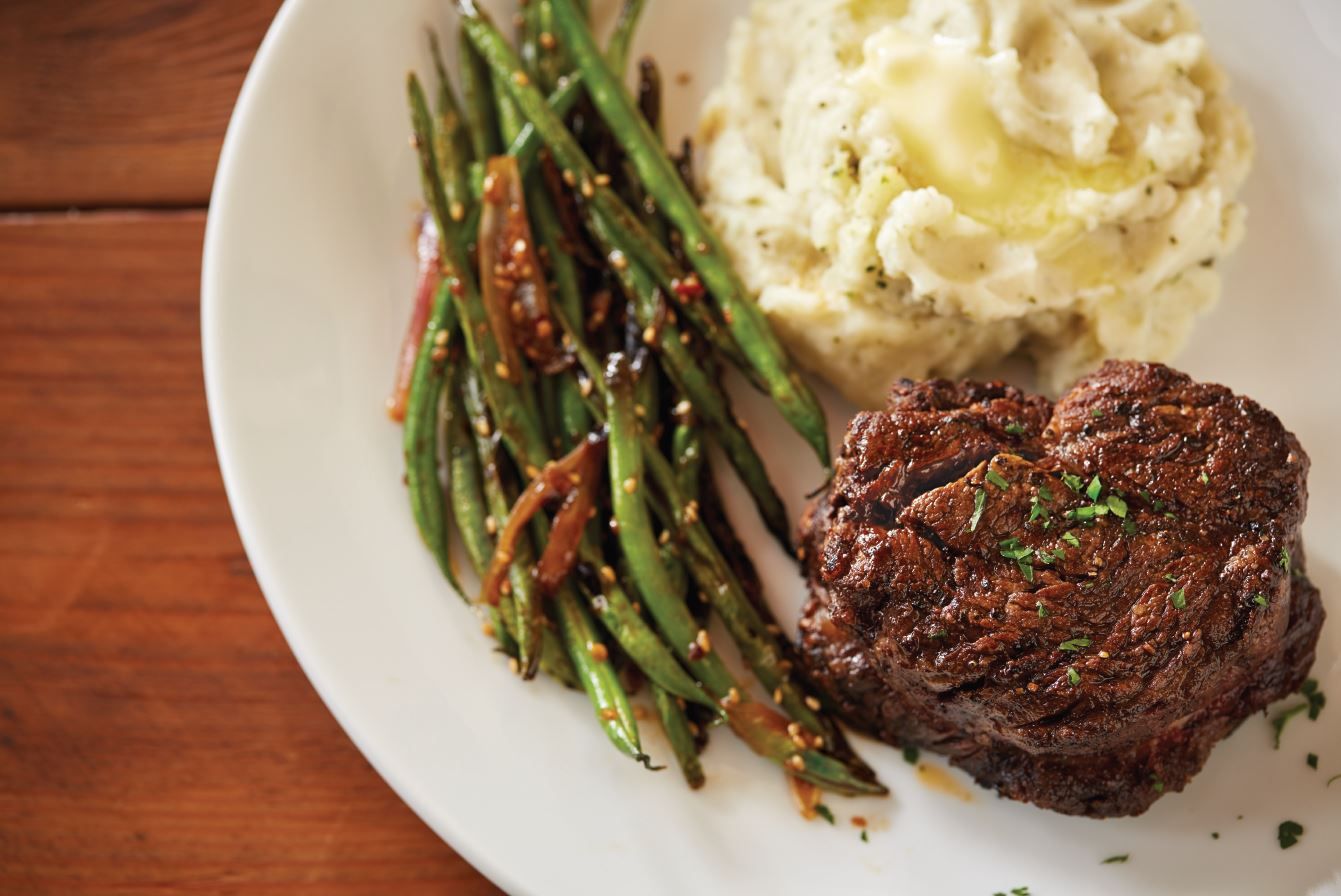 Prices
across the board at Fleming’s are competitive with
those in NYC, although you might think they’d be a
tad lower, given that this is New Jersey in a
shopping mall.
Prices
across the board at Fleming’s are competitive with
those in NYC, although you might think they’d be a
tad lower, given that this is New Jersey in a
shopping mall.
But at
least this single location proves that with
attention to detail and especially to product and service, a chain
steakhouse can compete with any independent
steakhouse anywhere. And, unlike so many
window-less steakhouses in Manhattan, you get
that nonpareil view. Cue
“Rhapsody in Blue!”
Open nightly for dinner.
❖❖❖
STOCKING 66 WINE CELLARS: AN INTERVIEW WITH MAEVE PESQUERA,
National Wine Director for Fleming's Prime Steakhouse & Wine Bars
By John
Mariani

In order to find out
how a steakhouse chain with 66 branches
coordinates its wine lists for restaurants
in different parts of the country, I spoke
with Maeve Pesquera, Fleming’s Prime
Steakhouse & Wine Bar’s National
Director of Wine, who
oversees the chain’s wine program,
highlighted by the Fleming’s 100®, a
collection of 100 wines by the glass, all
also available by the taste, flight or
bottle.
Pesquera,
who joined the company in 2002 at the
Houston branch, also helped develop
Fleming’s WiNEPAD™, a proprietary web
application that provides label-specific
tasting notes, the story behind the wine,
and innovative ways to learn about wine.
Each year she seeks out a
winemaker to produce a custom blend for
Fleming’s Forty-Six Diamonds, released in the
fall at all locations, and also oversees the
chain’s cocktail program, focusing on
up-and-coming boutique and family-owned
wineries and distilleries, while developing
seasonal cocktail offerings.
Pesquera attended the Conrad Hilton College of
Hotel & Restaurant Management at the U. of
Houston, where she is a guest lecturer
and mentor to those seeking careers in the
hospitality industry. Pesquera,
her husband Luis and their five children live
in Laguna Beach, CA.
Q: Describe your
overall job at Fleming’s.
A:
My job is straightforward: It’s to help
people feel confident about wine and to create an
experience that carries over into their daily
lives 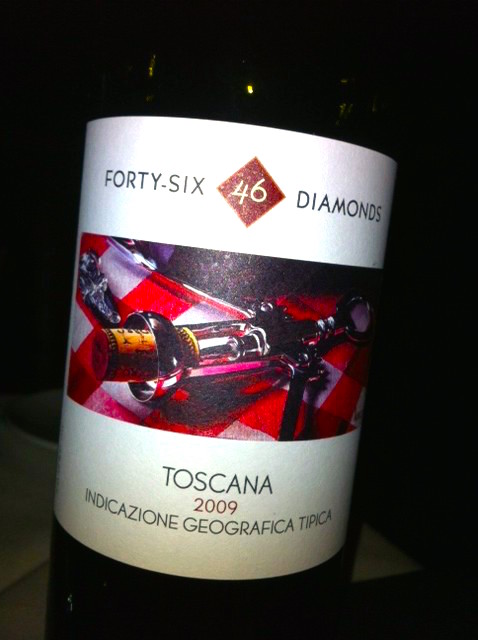 as they
select, savor and explore wine. I do this in
several ways: First, with the Fleming’s 100, which
is a powerful way to bring wine to life for people
in an approachable way — to demystify wine, to
make it fun! The extension of the F100 is the
Fleming’s WiNEPAD (below), which we created to open
the conversation between the guest and the server
to enhance the dialogue about wine. The
information on the WiNEPAD extends far beyond a
digital wine list;
it engages and informs our guests, empowers
them to make great selections and have fun at the
same time.
as they
select, savor and explore wine. I do this in
several ways: First, with the Fleming’s 100, which
is a powerful way to bring wine to life for people
in an approachable way — to demystify wine, to
make it fun! The extension of the F100 is the
Fleming’s WiNEPAD (below), which we created to open
the conversation between the guest and the server
to enhance the dialogue about wine. The
information on the WiNEPAD extends far beyond a
digital wine list;
it engages and informs our guests, empowers
them to make great selections and have fun at the
same time.
Q:
What’s
the
most rewarding part of your job?
A: A really rewarding part of my
job is creating educational platforms that are
meaningful for our associates and wine managers.
This means providing information in a way that
helps them in their roles as wine educators and to
be the voice of the Fleming’s wine program at
every table. We
bring this to life through the Fleming’s
experience. People can get a glass of wine
anywhere. But at Fleming’s we strive to do more.
We want to meet everyone wherever they are on
their journey with wine. That may be a through a
thoughtful recommendation that helps them find
their new favorite wine or by participation in one
of our special wine events held throughout the
year. The
Fleming’s experience underscores that we are more
than just a steakhouse — we are a wine bar.
Q: You must do a
tremendous amount of traveling, with 66 units.
A:
Travel
is an integral part of my job. In addition to
traveling nationwide to visit Fleming’s locations,
I also travel frequently to wine growing regions,
which gives me time with winemakers up close. I get
to experience what they are working on and are
most excited about. In the past year, I have been
to Burgundy, Champagne, Napa, Sonoma, Oregon and
Brazil. While few people think of Brazil as a
wine-growing region, in fact, it is an
up-and-coming viticultural area. I loved being
there during harvest, connecting with the
winemakers and experiencing their passion and
expertise.
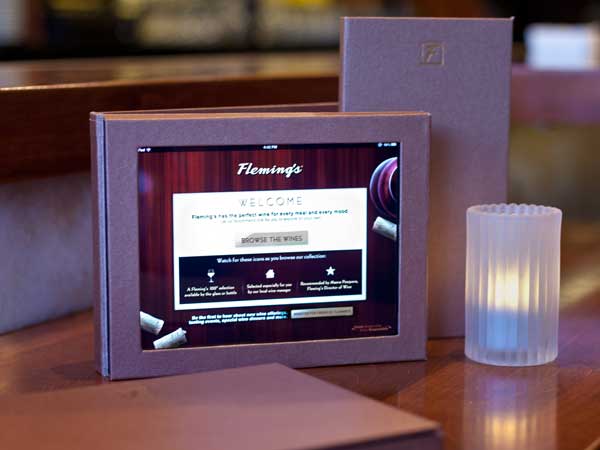 Q: Do
you choose wines for all the units or design
each separately?
Q: Do
you choose wines for all the units or design
each separately?
A:
I create the national F100 and Reserve wine
lists that are available at every location. Every
Fleming’s has a designated Wine Manager, whose job
is to bring wine to life for their people every
night. This includes maintaining a wine selection
that speaks to the guests in their particular
locales. These additions could be locally produced
wines, cult classics, or other wines that their
guests crave.
Q. Are you able to
get good prices because of your clout in the
market?
A: I can’t tell you all my secrets at once! But I will say that we have created solid, long-standing partnerships with winemakers and wineries across the globe. Our reach allows us to support smaller, family owned, up and coming wineries and help them get distribution across the country, which is always a challenge for them. Over the years, we have seen many small wineries establish a national presence because of their placement at Fleming’s.
Q: How would you
describe the overall list? What does it
favor?
A: The list is a reflection of
what people are really drinking across the U.S. in
the fine dining segment. The strength of offering
100 wines by the glass is that we are able to truly offer something for
everyone, both in variety of offerings and in
price point. Because
we are a steakhouse, the list does include a large
number of Cabernets—we offer 19 by the
glass—allowing Cabernet enthusiasts to explore new
wines in their favorite varietal. But our
guests, somewhat
surprisingly for a steakhouse, drink a lot of
white wine, with Riesling at the very top of that
list. Much of that is enjoyed as an aperitif or as a
pairing with menu items other than steak. And so
our list mirrors those preferences, with a large
percentage of the list allocated to sparkling
wines, refreshing white varietals like Torrontes,
Grüner Veltliner, and fuller bodied whites such as
Viognier and Chardonnay. We find
that as people continue their love affair with
Pinot Noir, this section has grown substantially
throughout the years on our lists. The “heartbreak
grape” abounds in many forms, from the major
growing regions known to produce the best of this
sultry varietal.
And for our guests who want to experience
and explore the world of wine, our list can take
them there with our Global Reds section. Nero D’
Avola, Corvina, Grenache, Syrah, Tempranillo and
Sangiovese are some of the by the glass selections
we offer.
Q: Do you not buy
certain wines you yourself love because they
wouldn't fit the list?
A: Fortunately,
I love wine, so I can honestly say that I enjoy
every wine that is on our list. But my job is to
create a wine list that appeals to all our guests
wherever they are on their journey with wine. So,
just like your iTunes playlist is different than
mine, the “Maeve 100” might be a bit different
than the “F100.” It would definitely share many of
the same selections but might have added depth in
a few of the genres—in my case, Burgundy.
Q: Do you see any
trends in steakhouse wine lists?
A: Yes: Steakhouses
are expanding their by-the-glass lists. Guests
are ordering differently now. Some aren’t drinking
as much wine as before. Others prefer not to
commit to an entire bottle and instead move from
varietal to varietal and explore different growing
regions. 
Q: We talked about
how the days when the investment bankers and
high rollers nightly bought the $500-$4,000
wines like Château Pétrus and Romanée-Conti.
How has this changed?
A: The recession of 2008
readjusted guests’ perspectives on everyday
indulgence of high-end wines. Every restaurant
loves to brag about the high-end wines it sells,
but since 2008, that is not what is happening
day-to-day. Throughout the ages, people in wine
producing areas have cherished and enjoyed great
wines on a daily basis that are not First Growth
Bordeaux or the Grand Cru Burgundies. This shift
has refocused our guests on what wine lovers have
always known, that great wines don’t always have
to come with a high price. And this new awareness
has challenged us to find wines whose quality far
outpaces the price.
Q: Are California cabs and chardonnays
still the best sellers?
A:
Cabernet and Chardonnay are the historical
strengths of a steakhouse wine list. People who
love Cabernet really love
Cabernet. While they may not be as apt to expand
beyond that category, they are interested in
expanding within
that category—perhaps a Cabernet from Argentina, a
Cabernet blend (part of the new booming red blend
trend) and over into Bordeaux, which is all within
their favorite flavor profile. The trend of
lighter oaked Chardonnays, often from cooler
growing sites, with fewer buttery notes as well as
Chardonnays that are aged on the lees for texture
have re-energized the Chardonnay category. These
wines have a broader appeal and many new wine
drinkers are now embracing this style.
Q: What do women
tend to order at Fleming's and how do you keep
it female friendly?
A: From day one, Fleming’s sought
to create a steakhouse where women felt
comfortable. In 1998, this meant the disruptive
strategy of creating a completely non-smoking
restaurant, which was simply unheard of back
then--especially in a steakhouse. Fleming’s is
centered on warm hospitality and knowledgeable but
friendly service, which also creates a welcoming
environment.
Personally I am a bone-in
ribeye girl and my older brother is a filet mignon
fan. So a lot of the old conventions about who
wants what are changing. We are all eating
differently these days. And items like our small
plates, seasonally focused menu and bar menu
items, like our housemade burrata,
reflect those changes. It’s one of the most
exciting things about being in the restaurant
business now, observing the changes in the way
people dine and anticipating where guests will go
next.
Q:
Why is Fleming's not in NYC?
A: New
York is a city who knows a great steak. We would
love to be in NYC. Although a NY location is not
on the drawing board at the moment, it’s certainly
on our radar and on our wish list.
Q: How important are restaurants to the wine market and allocation?
A:
Restaurants are vitally important because they
offer a national stage for wines and wineries. In
many cases, restaurants may be the only
place where a person can even access a particular
wine. When people experience a wine at a
restaurant they are sharing that wine in the
company of friends and family. This creates a
positive emotional connection with that wine and
they seek it out and buy it again.
Brought to you by BANFI VINTNERS
DO YOU TRUST THE OPINION OF A SOMMELIER?
If you’re an oenophile who frequently
enjoys fine dining you likely know the “insider’s”
secret to getting a great bottle of wine to pair with
your dinner at a restaurant – ask the sommelier.
There’s an ironic epiphany that occurs at some point
in the journey of one who studies wine: the more you
know about wine, the more you realize how much you
DON’T know about wine. Sure, a collector may know
every nuance of the Napas in his or her cellar, and
the harvest reports for all the Rhones. But that
knowledge isn’t helpful when the restaurant wine list
offers only a selection of Super Tuscans.
Further, no one’s palate can
possibly know – and remember – how every wine
interacts with every dish. It gets more complicated
when you learn that the best wines develop and change
over time; a closed-up Barolo today might blossom in
just a few months. That’s why the best restaurants
employ sommeliers – they’re there to ensure that you
have the very best wine and food experience on a
particular night.
 So if you
trust the opinion of a sommelier, is it safe to assume
you’d trust the collective opinion of twenty-six
somms?
So if you
trust the opinion of a sommelier, is it safe to assume
you’d trust the collective opinion of twenty-six
somms?
Recently, the third annual “Sommelier Challenge”
took place in San Diego, California. It is a wine
competition unlike any other, in that the entire panel
of judges assembled are active sommeliers. And not
just any somms – the lineup included some of the most
respected and certified sommeliers in the industry,
working the floors at many well-known fine dining
establishments throughout the USA. Somms from
Jean-Georges, The Mandarin Oriental, Bouchon Beverly
Hills, Del Posto, The Modern, Quince, Four Seasons,
Charlie Palmer Steakhouse, and many others judged
nearly 1,200 wines and spirits from over 20 countries,
rewarding only a fraction with a Platinum Medal, and
even fewer a “Best in
Class.” If you trust the word of one sommelier, it
makes sense to trust that of 26, doesn’t
it?
“Best in
Class.” If you trust the word of one sommelier, it
makes sense to trust that of 26, doesn’t
it?
Two wines by Banfi achieved both
Platinum and “Best in Class” distinction. Notes are
written by Competition Director and longtime wine
journalist Robert Whitley.
BEST OF
CLASS, BRUNELLO DI MONTALCINO: Castello Banfi, Brunello
di Montalcino 2010
Banfi has delivered a glorious Brunello from the
superb 2010 vintage. Showing exceptional purity of
fruit, this is a well-balanced Tuscan red that is
structured for long-term aging although it's pretty
enough to drink now. Packed with sweet black cherry
fruit balanced by fresh acidity and fine tannins, the
mid-palate is rich and satisfying. The finish shows a
bit of grip, but will lengthen as the wine matures. It
is clearly one of the wines of the vintage in
Montalcino. A Platinum award-winner at the 7th annual
Sommelier Challenge International Wine Competition in
San Diego. A panel of advanced and master somms gave
it a score of 94 points.
BEST OF CLASS,
CHIANTI: Banfi,
Chianti Classico DOCG Riserva 2011
This is perhaps the greatest value in an imported red
wine today. A panel of advanced and master sommeliers
at the 7th annual Sommelier Challenge International
Wine Competition awarded this Chianti Classico Riserva
from Banfi a Platinum award and a huge score of 95
points. It's easy to see why. Packed with tart cherry
fruit and beautifully balanced and firmly structured,
this is a Chianti that would benefit from an
additional eight to 10 years in the cellar, clearly a
wine with a bright promising future; a remarkable wine
that you can easily find for less than $20 a bottle.
For more Banfi news, wine
education, recipes, and wine-food pairings, visit http://BanfiBlog.com
Any of John Mariani's books below may be ordered from amazon.com.
 I'm proud and happy to announce that my
new book, The Hound
in Heaven (21st Century Lion Books), has just
been published through Amazon and Kindle.
I'm proud and happy to announce that my
new book, The Hound
in Heaven (21st Century Lion Books), has just
been published through Amazon and Kindle. It is a novella, and for anyone who loves dogs, Christmas, romance, inspiration, even the supernatural, I hope you'll find this to be a treasured favorite. The story concerns how, after a New England teacher, his wife and their two daughters adopt a stray puppy found in their barn in northern Maine, their lives seem full of promise. But when tragedy strikes, their wonderful dog Lazarus and the spirit of Christmas are the only things that may bring back his master back from the edge of despair.
WATCH THE VIDEO!
“What a huge surprise turn this story took! I was completely stunned! I truly enjoyed this book and its message.” – Actress Ali MacGraw
“He had me at Page One. The amount of heart, human insight, soul searching, and deft literary strength that John Mariani pours into this airtight novella is vertigo-inducing. Perhaps ‘wow’ would be the best comment.” – James Dalessandro, author of Bohemian Heart and 1906.
“John Mariani’s Hound in Heaven starts with a well-painted portrayal of an American family, along with the requisite dog. A surprise event flips the action of the novel and captures us for a voyage leading to a hopeful and heart-warming message. A page turning, one sitting read, it’s the perfect antidote for the winter and promotion of holiday celebration.” – Ann Pearlman, author of The Christmas Cookie Club and A Gift for my Sister.
“John Mariani’s concise, achingly beautiful novella pulls a literary rabbit out of a hat – a mash-up of the cosmic and the intimate, the tragic and the heart-warming – a Christmas tale for all ages, and all faiths. Read it to your children, read it to yourself… but read it. Early and often. Highly recommended.” – Jay Bonansinga, New York Times bestselling author of Pinkerton’s War, The Sinking of The Eastland, and The Walking Dead: The Road To Woodbury.
“Amazing things happen when you open your heart to an animal. The Hound in Heaven delivers a powerful story of healing that is forged in the spiritual relationship between a man and his best friend. The book brings a message of hope that can enrich our images of family, love, and loss.” – Dr. Barbara Royal, author of The Royal Treatment.
 |
The Encyclopedia of American Food and Drink by John F. Mariani (Bloomsbury USA, $35) Modesty forbids me to praise my own new book, but let me proudly say that it is an extensive revision of the 4th edition that appeared more than a decade ago, before locavores, molecular cuisine, modernist cuisine, the Food Network and so much more, now included. Word origins have been completely updated, as have per capita consumption and production stats. Most important, for the first time since publication in the 1980s, the book includes more than 100 biographies of Americans who have changed the way we cook, eat and drink -- from Fannie Farmer and Julia Child to Robert Mondavi and Thomas Keller. "This book is amazing! It has entries for everything from `abalone' to `zwieback,' plus more than 500 recipes for classic American dishes and drinks."--Devra First, The Boston Globe. "Much needed in any kitchen library."--Bon Appetit. |
"Eating Italian will never be the same after reading John Mariani's entertaining and savory gastronomical history of the cuisine of Italy and how it won over appetites worldwide. . . . This book is such a tasteful narrative that it will literally make you hungry for Italian food and arouse your appetite for gastronomical history."--Don Oldenburg, USA Today. "Italian
restaurants--some good, some glitzy--far
outnumber their French rivals. Many of
these establishments are zestfully described
in How Italian Food Conquered the World, an
entertaining and fact-filled chronicle by
food-and-wine correspondent John F.
Mariani."--Aram Bakshian Jr., Wall Street
Journal.
"Equal parts
history, sociology, gastronomy, and just
plain fun, How Italian Food Conquered the
World tells the captivating and delicious
story of the (let's face it) everybody's
favorite cuisine with clarity, verve and
more than one surprise."--Colman Andrews,
editorial director of The Daily
Meal.com. "A fantastic and fascinating
read, covering everything from the influence
of Venice's spice trade to the impact of
Italian immigrants in America and the
evolution of alta cucina. This book will
serve as a terrific resource to anyone
interested in the real story of Italian
food."--Mary Ann Esposito, host of PBS-TV's
Ciao
Italia. "John Mariani has written the
definitive history of how Italians won their
way into our hearts, minds, and
stomachs. It's a story of pleasure over
pomp and taste over technique."--Danny Meyer,
owner of NYC restaurants Union Square
Cafe, The Modern, and Maialino.
|
 |
 |
 |
 |
 |
 |
 |
 |
 Everett Potter's Travel Report:
Everett Potter's Travel Report: 
 Eating Las
Vegas is the new on-line site for
Virtual Gourmet contributor John A. Curtas.,
who since 1995 has been commenting on the
Las Vegas food scene and reviewing
restaurants for Nevada Public Radio.
He is also the restaurant critic for KLAS
TV, Channel 8 in Las Vegas, and his past
reviews can be accessed at KNPR.org.
Click on the logo below to go directly to
his site.
Eating Las
Vegas is the new on-line site for
Virtual Gourmet contributor John A. Curtas.,
who since 1995 has been commenting on the
Las Vegas food scene and reviewing
restaurants for Nevada Public Radio.
He is also the restaurant critic for KLAS
TV, Channel 8 in Las Vegas, and his past
reviews can be accessed at KNPR.org.
Click on the logo below to go directly to
his site.

Tennis Resorts Online: A Critical Guide to the World's Best Tennis Resorts and Tennis Camps, published by ROGER COX, who has spent more than two decades writing about tennis travel, including a 17-year stretch for Tennis magazine. He has also written for Arthur Frommer's Budget Travel, New York Magazine, Travel & Leisure, Esquire, Money, USTA Magazine, Men's Journal, and The Robb Report. He has authored two books-The World's Best Tennis Vacations (Stephen Greene Press/Viking Penguin, 1990) and The Best Places to Stay in the Rockies (Houghton Mifflin, 1992 & 1994), and the Melbourne (Australia) chapter to the Wall Street Journal Business Guide to Cities of the Pacific Rim (Fodor's Travel Guides, 1991).


MARIANI'S VIRTUAL GOURMET
NEWSLETTER is published weekly. Editor/Publisher: John
Mariani.
Editor: Walter Bagley. Contributing Writers: Christopher Mariani,
Robert Mariani, Misha
Mariani,
John A. Curtas, Edward Brivio, Mort Hochstein,
Andrew Chalk, Dotty Griffith and Brian Freedman. Contributing
Photographers: Galina Dargery, Bobby
Pirillo. Technical Advisor: Gerry McLoughlin.
To un-subscribe from this newsletter,click here.
© copyright John Mariani 2015

